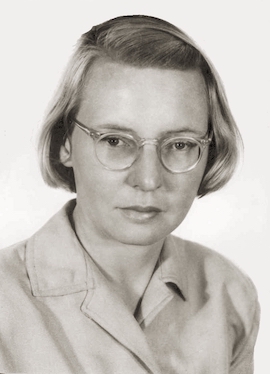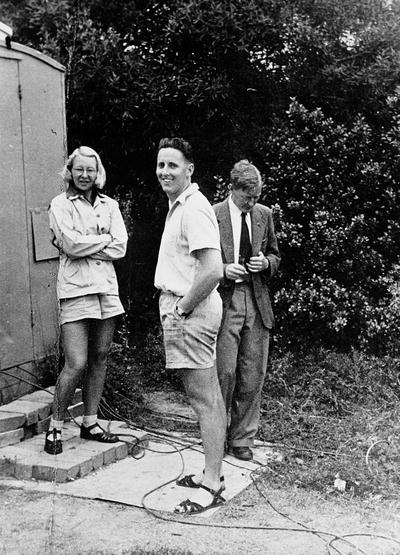Written by Elizabeth Heffernan, RAHS Volunteer
To celebrate Women’s History Month in 2021, the Royal Australian Historical Society will continue our work from previous years to highlight Australian women that have contributed to our history in various and meaningful ways. You can browse the women featured on our webpage, Women’s History Month.
Ruby Payne-Scott was Australia’s first woman radio astronomer. Though relatively unknown during her lifetime, due to both the obscurity of her work and wartime confidentiality, today Ruby is recognised as a pioneer in solar radio astronomy. Seventy years after her retirement in 1951, her work remains foundational in a field that would not exist without her.

RUBY PAYNE-SCOTT DURING HER STUDENT YEARS. [IMAGE COURTESY BILL HALL FAMILY COLLECTION.]
Ruby was born in Grafton and attended Sydney Girl’s High School. She obtained a Bachelor of Science with first class honours from the University of Sydney in 1933, a Masters of Science specialising in radiation physics in 1936, and a Diploma of Education in 1938. At the time of her Bachelor’s she was only the third woman to receive a physics degree from the university. [1]
World War II marked the turning point for Ruby’s career. Like so many other women, she found work in a traditionally male-dominated career and, later, at an equal rate of pay. The Commonwealth Scientific and Industrial Research (CSIR, later the CSIRO) Radiophysics Laboratory employed Ruby in 1941. Her top-secret work involved enabling radar systems to track incoming Japanese fighter planes. Ruby became an expert.
Her career continued to flourish after the war. Along with Joseph Pawsey, she carried out the first radio astronomy experiment in the southern hemisphere at Sydney University, in 1944. [2] The following year she conducted pioneering solar radio astronomy observations at Dover Heights, near Bondi. Between 1945-47, Ruby helped discover three of five categories of solar bursts originating in the solar corona. She played a leading role in the design, construction, and use of a ‘swept lobe’ interferometer which enabled rapid imaging of the sun. Her most significant contribution was the development of the Fourier synthesis technique, giving radio astronomers a clearer understanding of space wave shape and frequency. Her method is still widely used today. [3]

RUBY AT WORK, PICTURED HERE WITH ALEC LITTLE AND CHRIS CHRISTIANSEN AT THE POTTS HILL RESERVOIR, LIKELY IN 1948. [IMAGE COURTESY CSIRO RADIO ASTRONOMY IMAGE ARCHIVE, B14315.]
Ruby married Bill Hall in 1944. Knowing she would legally be required to retire from the CSIRO, she kept their union hidden until 1950. When discovered, Ruby lost her permanent position and all her pension rights. She retired the following year at 39, pregnant with the first of two children. There was no such thing as maternity leave. In 2008 the CSIRO established the Ruby Payne-Scott Award to support researchers who have taken extended leave for parenting or other family duties. Ruby would be proud. [6]
It is astonishing to realise that Ruby’s career as a radio astronomer spanned less than a decade, for her contributions to the field are colossal. After a number of years spent at home Ruby returned to the workforce as a teacher, retiring for good in 1974. She died in 1981, three days before her 69th birthday. Ruby and Bill raised their family in Oatley, in a house they built with extra large doors. On clear nights they would take their bed outside to sleep in the open, looking up at the stars. [7]
References:
[1] Ragbir Bhathal, ‘Payne-Scott, Ruby’, in Biographical Encyclopedia of Astronomers, ed. Thomas Hockey, et al. (New York: Springer, 2014), https://link.springer.com/referenceworkentry/10.1007/978-1-4419-9917-7_9332.
[2] W.M. Goss and Claire Hooker, ‘Payne-Scott, Ruby Violet (1912-1981)’, Australian Dictionary of Biography, National Centre of Biography, Australian National University, https://adb.anu.edu.au/biography/payne-scott-ruby-violet-15036, accessed 23 February 2021.
[3] Colin Ward, ‘Ruby Payne-Scott [1912-1981]’, CSIROpedia, 23 March 2011, https://csiropedia.csiro.au/payne-scott-ruby/; Rebecca Halleck, ‘Overlooked No More: Ruby Payne-Scott, Who Explored Space With Radio Waves’, New York Times, 29 August 2018, https://www.nytimes.com/2018/08/29/obituaries/ruby-payne-scott-overlooked.html.
[4] Ward, ‘Ruby Payne-Scott’.
[5] Bhathal, ‘Payne-Scott, Ruby’; ‘Ruby Payne-Scott – Radio Astronomer’, Science Show, ABC Radio National, 14 February 2004, https://www.abc.net.au/radionational/programs/scienceshow/ruby-payne-scott—radio-astronomer/3403336.
[6] Ward, ‘Ruby Payne-Scott’; Dorothy Erickson, ‘Payne-Scott, Ruby Violet’, Encyclopedia of Women and Leadership in Twentieth-Century Australia, https://www.womenaustralia.info/entries/payne-scott-ruby-violet/, accessed 23 February 2021.
[7] ‘Ruby Payne-Scott’, Science Show.

0 Comments